The SandForce Roundup: Corsair, Kingston, Patriot, OCZ, OWC & MemoRight SSDs Compared
by Anand Lal Shimpi on August 11, 2011 12:01 AM ESTAnandTech Storage Bench 2011
Last year we introduced our AnandTech Storage Bench, a suite of benchmarks that took traces of real OS/application usage and played them back in a repeatable manner. I assembled the traces myself out of frustration with the majority of what we have today in terms of SSD benchmarks.
Although the AnandTech Storage Bench tests did a good job of characterizing SSD performance, they weren't stressful enough. All of the tests performed less than 10GB of reads/writes and typically involved only 4GB of writes specifically. That's not even enough exceed the spare area on most SSDs. Most canned SSD benchmarks don't even come close to writing a single gigabyte of data, but that doesn't mean that simply writing 4GB is acceptable.
Originally I kept the benchmarks short enough that they wouldn't be a burden to run (~30 minutes) but long enough that they were representative of what a power user might do with their system.
Not too long ago I tweeted that I had created what I referred to as the Mother of All SSD Benchmarks (MOASB). Rather than only writing 4GB of data to the drive, this benchmark writes 106.32GB. It's the load you'd put on a drive after nearly two weeks of constant usage. And it takes a *long* time to run.
1) The MOASB, officially called AnandTech Storage Bench 2011 - Heavy Workload, mainly focuses on the times when your I/O activity is the highest. There is a lot of downloading and application installing that happens during the course of this test. My thinking was that it's during application installs, file copies, downloading and multitasking with all of this that you can really notice performance differences between drives.
2) I tried to cover as many bases as possible with the software I incorporated into this test. There's a lot of photo editing in Photoshop, HTML editing in Dreamweaver, web browsing, game playing/level loading (Starcraft II & WoW are both a part of the test) as well as general use stuff (application installing, virus scanning). I included a large amount of email downloading, document creation and editing as well. To top it all off I even use Visual Studio 2008 to build Chromium during the test.
The test has 2,168,893 read operations and 1,783,447 write operations. The IO breakdown is as follows:
| AnandTech Storage Bench 2011 - Heavy Workload IO Breakdown | ||||
| IO Size | % of Total | |||
| 4KB | 28% | |||
| 16KB | 10% | |||
| 32KB | 10% | |||
| 64KB | 4% | |||
Only 42% of all operations are sequential, the rest range from pseudo to fully random (with most falling in the pseudo-random category). Average queue depth is 4.625 IOs, with 59% of operations taking place in an IO queue of 1.
Many of you have asked for a better way to really characterize performance. Simply looking at IOPS doesn't really say much. As a result I'm going to be presenting Storage Bench 2011 data in a slightly different way. We'll have performance represented as Average MB/s, with higher numbers being better. At the same time I'll be reporting how long the SSD was busy while running this test. These disk busy graphs will show you exactly how much time was shaved off by using a faster drive vs. a slower one during the course of this test. Finally, I will also break out performance into reads, writes and combined. The reason I do this is to help balance out the fact that this test is unusually write intensive, which can often hide the benefits of a drive with good read performance.
There's also a new light workload for 2011. This is a far more reasonable, typical every day use case benchmark. Lots of web browsing, photo editing (but with a greater focus on photo consumption), video playback as well as some application installs and gaming. This test isn't nearly as write intensive as the MOASB but it's still multiple times more write intensive than what we were running last year.
As always I don't believe that these two benchmarks alone are enough to characterize the performance of a drive, but hopefully along with the rest of our tests they will help provide a better idea.
The testbed for Storage Bench 2011 has changed as well. We're now using a Sandy Bridge platform with full 6Gbps support for these tests. All of the older tests are still run on our X58 platform.
AnandTech Storage Bench 2011 - Heavy Workload
We'll start out by looking at average data rate throughout our new heavy workload test:

Our Storage Bench suite groups performers according to die count/drive capacity. The 240GB drives are faster than the 120GB counterparts. There's also not much of a difference between the drives with synchronous vs. asynchronous NAND.
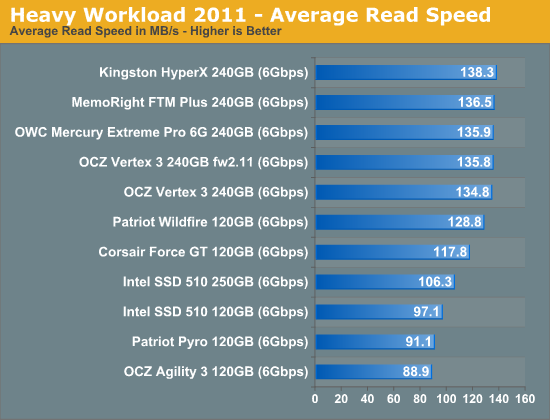
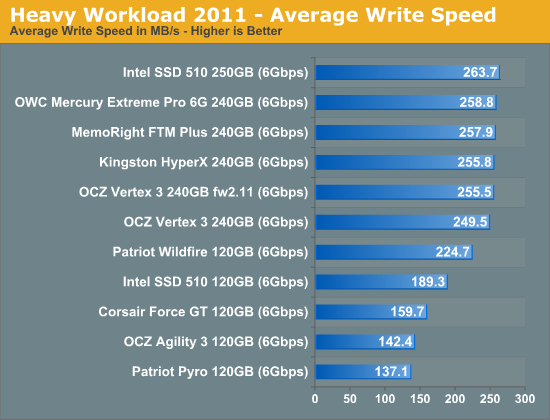
The next three charts just represent the same data, but in a different manner. Instead of looking at average data rate, we're looking at how long the disk was busy for during this entire test. Note that disk busy time excludes any and all idles, this is just how long the SSD was busy doing something:
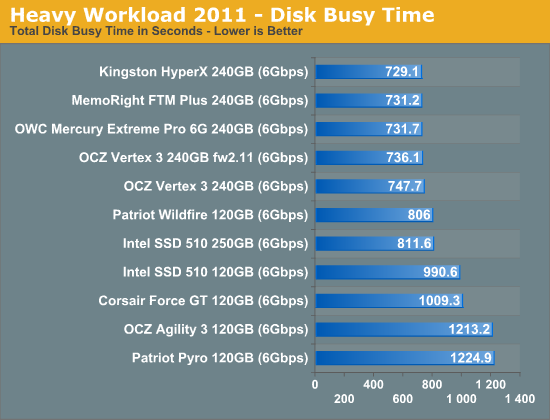
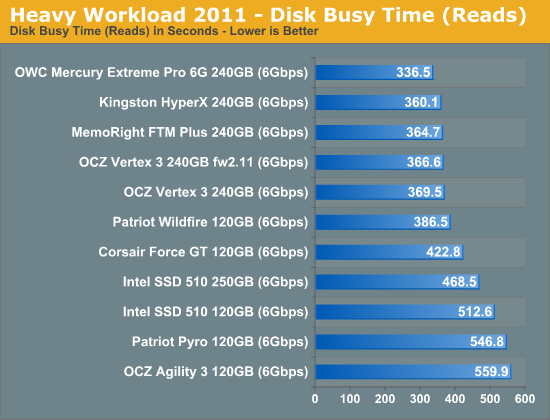
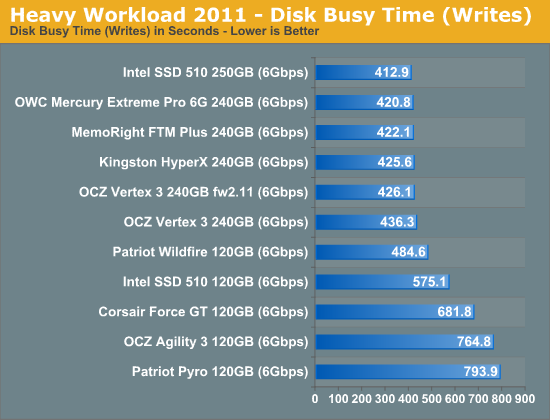










90 Comments
View All Comments
bobbyh - Thursday, August 11, 2011 - link
FIRST!Are you going to talk about synchronous vs asynchronous NAND and the benefits of one vs the other?
bobbyh - Thursday, August 11, 2011 - link
nevermind lol!bobbyh - Thursday, August 11, 2011 - link
very nice roundup A+ would read againArnulf - Thursday, August 11, 2011 - link
FIRST what ? FIRST idi0t to tag himself ? You got that right !ARoyalF - Thursday, August 11, 2011 - link
The estimated cost breakdown sure gave me an appreciation of what goe$ on behind the scenes.Sagath - Thursday, August 11, 2011 - link
Firstly, I'd state I always appreciated you bringing these issues to the front page to allow the consumer to see these issues in a public venue, while also berating manufacturers for selling us junk. Thank you, Anand.That being said; I fully understand that the new Sandforce chips allow SATA6 connectivity, and are thus the fastest possible drives on the market...yet I have to ask, is it worth it? I don't see you mentioning these issues with last gens drives like the aforementioned X25-m, or Sandforce v1.
Any SSD sold today is plainly 'fast', and order of magnitudes faster then magnetic-based storage. Is the incremental upgrade (of microseconds at best?) really worth sacrificing the reliability associated with last generations drives?
My X25-M and Vertex 2's across multiple computers, laptops and friends computers are all running flawlessly. I have had zero complaints about random BSOD's or lockups. I also have 2 friends with whom purchased Vertex 3's on their own, and are both experiencing the famous Sandforce v2 issues...
I'll stick with my 'slower' (lol?) X25-m's and V2's, then deal with these issues.
bobbyh - Thursday, August 11, 2011 - link
I have an older x25-m it still works flawlessly, this generation of drives has had an insane amount of problems.tbanger - Thursday, August 11, 2011 - link
Can anyone shed some more light on the Intel 320 series firmware problem that Anand mentions?I've experienced it recently myself with my work machine's 300GB model resetting itself to an 8MB partition with all data lost. Not a huge problem (good backup scheme) but still annoying. At least Intel kindly replaced my drive with a new one fairly quickly. However, given I had already ordered a bunch more drives for the company (before the failure), I would like to see a firmware update that fixes this problem. I'm getting nervous that we're going to experience a bunch of failures.
Is there any official plan to fix this from Intel? I haven't found much from Googling other than user complaints with little response from Intel.
Nickel020 - Thursday, August 11, 2011 - link
Just follow the link in the article ;)http://communities.intel.com/message/133499
They've reproduced the issue and are validating the firmware fix. I got not clue how long their validating could take, but a new FW could be out any day, or maybe it'll take another month. They might find some issues during validation, which need further fixes and then further validating, so not even someone from Intel could give you a definite ETA.
tbanger - Thursday, August 11, 2011 - link
That'll teach me to only skim the article :)Thanks for the link. Nice to see Intel to offer a little official feedback.